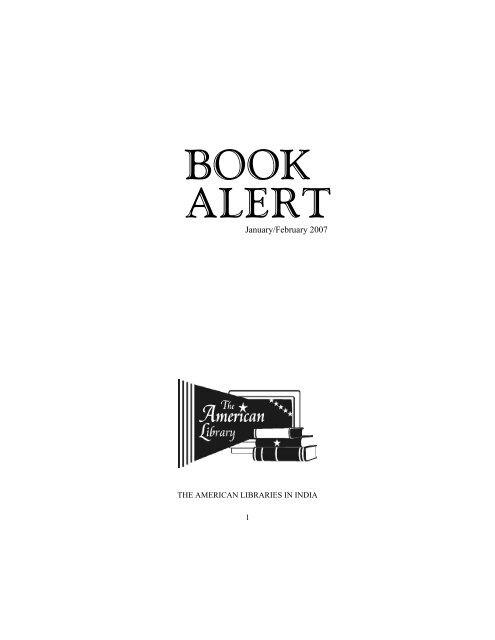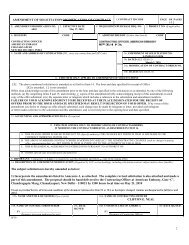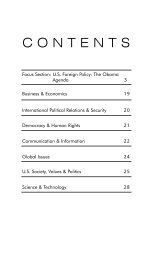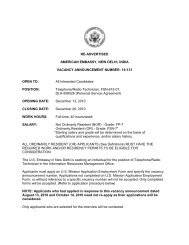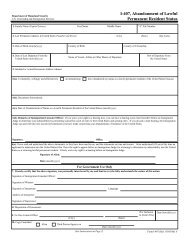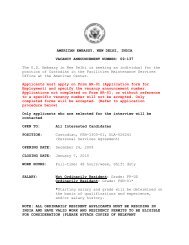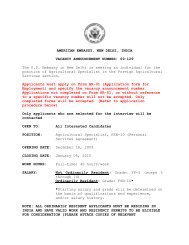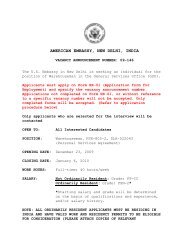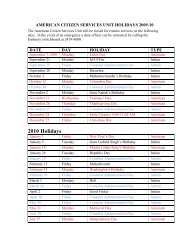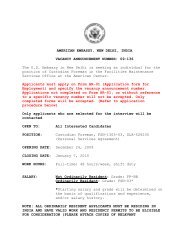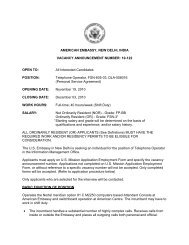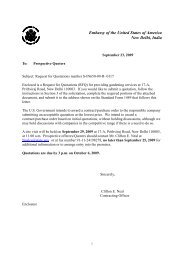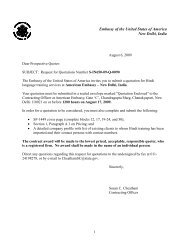Book Alert - American Library January February 2007 - New Delhi
Book Alert - American Library January February 2007 - New Delhi
Book Alert - American Library January February 2007 - New Delhi
You also want an ePaper? Increase the reach of your titles
YUMPU automatically turns print PDFs into web optimized ePapers that Google loves.
<strong>Book</strong>s listed in <strong>Book</strong> <strong>Alert</strong>—The <strong>American</strong> Libraries in India may beborrowed from The <strong>American</strong> <strong>Library</strong> nearest to you, and wecordially invite you to do so. Attached is a post-paid Request Card foryour use. Should you wish to borrow any of the titles listed, pleasefill in the card with your name and address (in BLOCK LETTERS),indicate item number and the title you wish to borrow, and mail it tothe <strong>Library</strong> nearest to you. The <strong>American</strong> <strong>Library</strong> will be happy tolend you books that are readily available and reserve those currentlyin circulation. You may request up to four books. At times, becauseof the great demand for new titles, your request may take some timeto fill, particularly in the case of books borrowed from another<strong>American</strong> <strong>Library</strong>. For your convenience, addresses of the four<strong>American</strong> Libraries are given on the inside front cover.Holdings of each <strong>American</strong> <strong>Library</strong> are indicated by symbols:C—Calcutta, CH—Chennai, M—Mumbai, and ND—<strong>New</strong> <strong>Delhi</strong>.Need any further assistance?Please feel free to write to Ms. Wendy A. Zaman,Information Resource Officer, Public Affairs Section, U.S. Embassy,The <strong>American</strong> Center, 24, Kasturba Gandhi Marg, <strong>New</strong> <strong>Delhi</strong> – 110 001.Compiled and edited by Sanjay Kumar Bhagat, Public Affairs Section,U.S. Embassy, <strong>New</strong> <strong>Delhi</strong>, India. Email: BhagatSK@state.gov2
CONTENTSArchitecture & Urban Planning 5The Arts 5Business & Management 7Communication 14Economics 15Education 17Environment 19History & Civilization 20Information Science & Technology 23Law 26Literature & Language 27Philosophy & Religion 33Political Science 34Psychology 37Science & Technology 38Sociology 40Author Index 43Title Index 433
ARCHITECTURE & URBAN PLANNING1. Gorman, Michael John.Buckminster Fuller : designing for mobility / Michael John Gorman.Skira, 2005. 207 p. REF 620 FULAlthough many books have been written about designer, architect,engineer, and philosopher R. Buckminster Fuller (1895-1983) and hisvisionary inventions, but Gorman has written a book that clearly stands apart.This title features 253 photographs, drawings, and blueprints – many of themnever published before – selected from Fuller's own archive. Gorman's overalltheme is that Fuller's lightweight, self-sufficient buildings were meant totravel (his geodesic domes have actually been airlifted by militaryhelicopters). Not merely prefabricated, they were planned to be assembled infactories, and then flown to their sites. Gorman points out that while notregarded seriously in his youth, Fuller later received support from universities,corporations, and the military for his work. The text offers insight into some ofFuller's concepts, such as his manifesto for mass-produced housing and histhoughts on the role of mobile shelter in transforming behavior. This titlepresents a worthy reading on Fuller. -- (For use only in the <strong>Library</strong>) M(Adapted from <strong>Library</strong> Journal, ©2005)THE ARTS2. America’s art, Smithsonian <strong>American</strong> Art Museum / [project manager]Theresa J. Slowik ; foreword by Eleanor Harvey ; introduction byElizabeth Broun. Smithsonian <strong>American</strong> Art Museum, , 2006. 322 p.REF 709.73 SMITo mark the grand reopening of the Smithsonian <strong>American</strong> ArtMuseum after several years on July 4, 2006, the museum created a capaciousand colorful volume showcasing 225 diverse works from its varied and stellarcollection. Expert and engaging commentary links the lushly reproducedartworks to the many-faceted story of America: its landscapes wild andcultivated, its small towns and big cities, its people indigenous and immigrant,and the myriad changes technology has instigated. Art itself has evolved insynchronization with social, political, and technological changes, a processclearly delineated in this stirring pageant, a procession that includes JohnSingleton Copley's 1765 portrait of the singularly self-possessed colonist5
Mrs. George Watson; George Catlin's 1832 portrait of a Native <strong>American</strong>beauty, Sha-ko-ka; Albert Bierstadt's grand 1868 vision of the Sierra Nevada;Civil War-era photographs; Berenice Abbott's photographs of 1930s <strong>New</strong>York; Jacob Lawrence's paintings of African <strong>American</strong> life; works by EdwardHopper and Willem de Kooning; and a video installation by Nam June Paik.Here is <strong>American</strong> art in all its glory and innovation as a quest forunderstanding and connection, and a public collection that constitutes agenuine national treasure. -- (For use only in the <strong>Library</strong>) CH/M/ND(Adapted from <strong>Book</strong>list, ©2006)3. Byars, Mel.The design encyclopedia / Mel Byars ; foreword by Terence Riley.Museum of Modern Art, ©2004. 832 p. REF 745.2 BYAThis definitive compendium of the world of modern design is themost comprehensive design reference guide that has been compiled from anumber of primary and secondary sources. It incorporates all essentials factspertaining to modern design including furniture and product design, graphicdesign, objects designed by architects, and the various styles and schools ofdesign of the late nineteenth, twentieth, and early twenty-first centuries. Heredesign is considered in terms of its concrete application to functional objects,relating it to craft, decorative arts, and industrial design. Illustrated with morethan 700 full-color illustrations, it represents the last 130 years in the historyof the design of furniture, lighting, fabrics, ceramics, glassware, metalware,objects in a range of other materials, and mechanical, electrical, and electronicappliances, as well as automobiles and some inventions. Entries are organizedalphabetically and cross-references have been given as and when applicablemaking it easy to navigate. The compilation is quite comprehensive andkeenly focused. People associated with design and designing would find it tobe an essential guide. -- (For use only in the <strong>Library</strong>) C/CH/M/ND(Adapted from <strong>Book</strong> <strong>New</strong>s, Inc., ©2005)6
BUSINESS & MANAGEMENT4. Badaracco, Joseph.Questions of character : illuminating the heart of leadership throughliterature / Joseph L. Badaracco, Jr. Harvard Business School Press,©2006. 221 p. 658.4092 BADThe syllabuses for the business ethics classes taught by Badaraccoread more like courses in the humanities than traditional business schoolcurricula. In Questions of Character, Joseph L. Badaracco shares insightsfrom eight classics that he explores in his MBA and executive educationcourses. These selections range from Sophocles' Antigone to Arthur Miller'sDeath of a Salesman. For each work, Badaracco raises a question thatilluminates an important aspect of character and allows readers to engage inwhat can become for them self-critiques related mainly to executiveleadership. Through rich analysis of the main characters in the selected stories,Badaracco addresses complex issues leaders face, such as the soundness oftheir vision, their readiness to take on responsibility, the depth of theircompassion, and their ability to manage success. Although we can't get insidethe minds of leaders in the workplace to learn what makes them tick, exploringthem through the lens of literature makes us intimately involved in thecharacters' lives as we digest their hopes, thoughts, decisions, actions,strengths, and flaws and learn what makes or breaks them. This literary anglewill be appreciated by the leaders and aspiring leaders and will help themprepare for the opportunities and tests before them. -- C/CH/M/ND(Adapted from <strong>Library</strong> Journal, ©2006)5. Catlett, Lowell B.Risk management in agriculture : a guide to futures, options, andswaps / Lowell B. Catlett, James D. Libbin. Thomson DelmarLearning, ©<strong>2007</strong>. 207 p. 630.681 CATRisk management in agriculture primarily addresses the issue ofmanaging the risk of price changes in the agricultural sector. The pricevariation has its impact not only on the marketing of the product, but also onthe overall financial health of the business. With the changing dynamics of theagricultural industry, the use of derivatives like futures contracts, optionscontracts, and swaps need to be seen as tools that could either be used solelyor in combination to control price risk. Risk managers not only need to knowwhich tool or their combination to be used, but also when they should be used.7
Modern risk managers need to supervise the use of the speculations to enhanceoverall profitability. Although, major portion of the book is dedicated to theprice risk management, it also addresses the management of other agriculturalrisks. To help readers understand the technical jargons, a complete glossary ofterms has been included at the end of the book. -- C/CH/M/ND6. Deshmukh, Ashutosh.Digital accounting : the effects of the Internet and ERP on accounting /Ashutosh Deshmukh. IRM Press, ©2006. 394 p. 657.0285 DESThe advent of the Internet and Enterprise Resource Planning (ERP)has provided a conceptual approach to handling the latest developments at theintersection of the accounting and IT fields. The book provides a foundation indigital accounting by covering fundamental topics such as accountingsoftware, XBRL (eXtensible Business Reporting Language), and EDI. It alsooffers a conceptual approach to handling the latest developments at theintersection of the accounting and IT fields. This convincing title is an attemptto capture the changes in accounting workflows, internal controls, and toolsdue to the electronic technology. The book would be particularly useful for thepracticing accountants and auditors who want to familiarize themselves withthe latest developments in this area. -- C/CH/M/ND7. Dychtwald, Ken.Workforce crisis : how to beat the coming shortage of skills and talent /Ken Dychtwald, Tamara J. Erickson, Robert Morison. HarvardBusiness School Press, ©2006. 269 p. 658.301 DYCThis timely book addresses the impact of the upcoming massiveretirement of the baby boomer generation and the following shortage ofskilled labor resulting in a workforce crisis in the United States. Tosurvive, the companies would have to work in advance and reorient theworkforce strategies and change their management and human resourcespractices to attract, engage and retain workers of all ages. Authors haveclassified the workforce into three categories – mature (55+ years old),mid-career (34-55 years old), and young (18-34 years old). These three setsof workers have completely different sets of temperament and careeraspirations. Companies must create a work climate and flexible benefitscatered to all the three age brackets. For ongoing success, the organizationswill have to take measures today to ensure that they have skilled andcommitted workers tomorrow. -- C/CH/M/ND8
8. The essentials of power, influence, and persuasion. Harvard BusinessSchool Press, ©2006. 289 p. 658.3 ESSPower, influence and persuasion are the key ingredients of success foreverybody especially for the people in the HR field. These skills can be learntand this book offers the advice and tools for harnessing these skills. Power isthe potential to allocate resources and to make and enforce decisions. Intoday’s corporate world, power is no longer absolute. On the contrary, it isdivided among the managers, executives, directors, and shareholders. Thus,the individual absolute power is now distributed in many components. Thishas led to the growing importance of influence and persuasion in the corporateHR departments. Influence, which is an extension of power, is the mechanismthrough which one can change others’ behavior or attitudes. It does notinclude execution of force, compulsion or direct command. It can even beexercised by those who have no formal power. It is a very important traitexpected from modern managers. Similarly, persuasion, which has no coercivecomponent, can be used to change or reinforce the attitudes, opinions, orbehaviors of others. Today’s corporate world operates with the help of power,influence, and persuasion. They are indispensable to the organizational andinterpersonal functions. -- C/CH/M/ND9. Govindarajan, Vijay.10 rules for strategic innovators : from idea to execution / VijayGovindarajan, Chris Trimble. Harvard Business School Press, ©2005.224 p. 658.406 GOVThis book is guided by the forces that lead a company to the road ofsuccess. It provides a roadmap for today’s entrepreneurs who wish to fosterthe development of new business concepts in a way that insulates them fromstandard corporate processes but allows them to draw on valuable corporateassets. Based on an in-depth study, the authors identify three centralchallenges for a company to succeed in today’s emerging uncertain market –forgetting, borrowing, and learning. The messages conveyed in this book areexecutable and works well in today’s business environment. -- C/CH/M/ND10. Harvard business review on appraising employee performance. HarvardBusiness School Press, ©2005. 186 p. 658.3125 HARThe importance of performance appraisals is fast catching up in thecorporate world these days. Businesspeople around the globe are now9
identifying the importance of appraisals in improving the performance of theemployees. In this compilation of articles by the experts in the field of humanresources, organizational behavior, psychology, and also by academics andconsultants in leadership, employees’ review process has been reviewed frommany angles. It also seeks to investigate as to how the appraisal process can becustomized to best suit the employee in question. This collection would bevery helpful for those concerned with retaining their star performers andguiding the underperformers. Readers introspecting their own performancewill also find the articles supportive in improving their own performance. Thebook definitely gives a new vision in best exploiting employee appraisals inmore productive ways. -- C/CH/M/ND11. Kim, W. Chan.Blue ocean strategy : how to create uncontested market space and makethe competition irrelevant / W. Chan Kim, Renée Mauborgne. HarvardBusiness School Press, ©2005. 240 p. 658.802 KIMThis groundbreaking book seeks to give a completely newperspective to the way companies perceive growth, see their competitors andtheir strategy to beat them, and take their market share. Kim and Mauborgnepresent a non-competitive approach for achieving high business growththrough the development of uncontested market space with practicallylimitless potential. Their blue ocean metaphor elegantly summarizes theirvision of expansion, competitor-free markets that innovative companies cannavigate. They argue that cutthroat competition results in nothing but a bloodyred ocean of rivals fighting over shrinking profit pool. Unlike "red oceans,"which are well-explored and crowded with competitors, "blue oceans"represent untapped market space and the opportunity for highly profitablegrowth. The only reason more big companies don't set sail for them, theysuggest, is that the dominant focus of strategy work over the past twenty-fiveyears has been on competition-based red ocean strategies – finding new waysto cut costs and grow revenue by taking away market share from thecompetitors. Kim and Mauborgne aim to repair that bias. Using dozens ofexamples – from Southwest Airlines and the Cirque du Soleil to Curves andStarbucks – they present the tools and frameworks they have developedspecifically for the task of analyzing blue oceans. They urge companies tovalue innovation that focuses on utility, price, and cost positions, to create andcapture new demand and to focus on the big picture, not the numbers. Whiletheir analytical tools may be of real use only to serious strategy planners, theiroverall vision will inspire entrepreneurs of all scales. Most of their ideas arepresented in a direct, jargon-free manner. It is a precise, actionable plan for10
changing the way companies do business. -- C/CH/M/NDPublishers Weekly, ©2005)(Adapted from12. Marquardt, Michael J.The manager as mentor / Michael J. Marquardt and Peter Loan.Praeger, ©2006. 191 p. REF 658.3124 MARIn today’s rapidly changing environment managers have achallenging role of mentoring and inspiring the people around them to learn.This resource for business managers explains how they can improve theirorganizations' chances for success by developing the capacity for mentoringothers. Diagnostic exercises help readers to assess their strengths andweaknesses and create an action plan for becoming an effective mentor. Theauthors also review some current trends in mentoring, such as cross-culturalpartnerships and action learning. -- (For use only in the <strong>Library</strong>) CH/M/ND(Adapted from <strong>Book</strong> <strong>New</strong>s, Inc., ©2006)13. Pfeffer, Jeffrey.Hard facts, dangerous half-truths, and total nonsense : profiting fromevidence-based management / Jeffrey Pfeffer, Robert I. Sutton. HarvardBusiness School Press, ©2006. 276 p. 658.403 PFEIn this outstanding and candid book, Pfeffer and Sutton debunkseveral managerial practices and challenge leaders to commit to evidencebasedmanagement as a way of organizational life. The existing commonpractices are often so well established that no one seemed to question themuntil the authors came along. In doing so, they demonstrate how companiescan bolster performance and trump the competition through evidence-basedmanagement, which is an approach to decision-making and action that isdriven by hard facts rather than half-truths or hype. According them, thedecisions and actions should be fact-based and should be the product of logicalthinking. Despite the fact that this evidence-based management is not thatcommon among public and private sector managers, it has taken its hold inmedicine and is spreading to education and public policy. Authors disapproveblind embracing of the existing practices and describe how to identify andapply practices that are best for the companies. The book is full of intriguingthoughts and is packed with practical wisdom. -- C/CH/M/ND11
14. Richman, Larry L.Improving your project management skills / Larry Richman. <strong>American</strong>Management Association, ©2006. 206 p. 658.404 RICImproving Your Project Management Skills is based on the <strong>American</strong>Management Association’s seminar of the same name. the book encompassesall major areas covered in the AMA seminar and provides step-by-stepguidelines on different aspects of project management – team leadership;scope of project; work breakdown; activity sequencing; analysis of time, cost,and resources; planning and budgeting; monitoring and controlling;completion of the project; and documentation. The powerful tools included inthis title will help streamline project execution and will also reduce cost. Atthe same time, it will also enhance productivity of the project. The book wouldprove to be powerful learning tool and a workplace reference for bothbeginners as well as the veterans. -- C/CH/M/ND15. Schwalbe, Kathy.Introduction to project management / Kathy Schwalbe. Thomson,©2006. 316 p. 658.404 SCHThis is a concise and introductory book on project management thatprovides up-to-date information on how good project, program, and portfoliomanagement can help achieve organizational success. Today, the success ofmost organizations depends on their project management capabilities, andthere is a growing industrial demand for this skill. This book caters to thisdemand and presents a framework for understanding and effectively exploitingproject management in the real-world situation. It is practical in approach andincludes many real-world examples that examine the factors leading to thesuccess or failure of the project. It talks about applying different tools andtechniques to a realistic project. The business world is dynamic and businessenvironmental factors are fast changing. The book takes this fact intoconsideration and admits that a conventional approach would not work well intoday’s circumstances. That’s why it emphasizes upon the tools andtechniques that will work well in today’s business circumstances. -- C/ND12
16. Sheffi, Yossi.The resilient enterprise : overcoming vulnerability for competitiveadvantage / Yossi Sheffi. MIT Press, ©2005. 338 p. 658.7 SHEIn this visionary book, Sheffi examines the supply chain breakdownsat companies like Amazon, Dell, General Motors, Intel and so on to show thatdisaster might not be frequent but it is inevitable. The Resilient Enterpriseexplores how various companies dealt with major disruptions in the last twodecades. Sheffi provides tools for companies to reduce the vulnerability of thesupply chain they live in. This is a crucial book for anyone involvedin operations and logistics to recognize the importance of building atruly flexible organization that can not only survive but thrive in a riskyworld. -- C/CH/M/ND17. Turban, Efraim.Introduction to information technology / Efraim Turban, R. KellyRainer, Jr., Richard E. Potter. 3rd ed. John Wiley & Sons, ©2005.REF 658.05 TURCurrent digital revolution poses the challenge of sustenance totoday’s business organizations. Despite transforming business landscape andintense competitive global market, the organizations have to sustain theirprofit. Information technology provides the tools that enable today’s corporatefunctional specialists to perform with high degree of efficiency. InformationTechnology is the basis for aggressive proactive strategies that can radicallyalter the competitive landscape of an industry. IT integrates and enhances allfunctions of a business – from the research and development that goes intodesigning a faster, more flexible board, to the delivery systems that make surestores receive stock in time for winter, to the point-of-sale systems that tracksales trends and customers' buying preferences. The book focuses primarily onthe application of the IT concepts to facilitate business processes. Written insimple comprehendible language, the text presents complex technicalinformation on a need-to-know basis. The book is practical in its approach andis filled with numerous real-world examples that demonstrate IT’s relevance todifferent disciplines, industries, and companies. -- (For use only in the<strong>Library</strong>) C/ND13
COMMUNICATION18. Beasley, Maurine Hoffman.First ladies and the press : the unfinished partnership of the media age /Maurine H. Beasley ; foreword by Caryl Rivers. NorthwesternUniversity Press, ©2005. 335 p. 973.91 BEAFirst Ladies and the Press investigates how U.S. presidential wiveshave handled journalists and media. The book starts with Eleanor Rooseveltand her women-only press conferences, which put the first lady into asymbiotic news-making relationship with the reporters who covered her. Herinteraction with the media led to the beginning of a partnership between thepress and the <strong>American</strong> presidential wife. Today, in the early twenty-firstcentury, first lady is the single most visible symbol of <strong>American</strong> womanhood.Maurine H. Beasley opines that the coverage of first ladies reflects quandariesover news values related to women and incorporates societal strains overchanging gender roles in <strong>American</strong> life. Looking at the personal interactionbetween each first lady from Martha Washington to Laura Bush and the massmedia of her day, she traces the growth of the institution of the first ladyas a part of the <strong>American</strong> political system. Her work reveals that themedia coverage of the first ladies has not adequately reflected the importanceof their role. -- C/CH/M/ND19. Stanley, William D.Electronic communications : principles and systems / William D.Stanley, John M. Jeffords. Thomson Delmar Learning, ©2006. 702 p.621.382 STAThis informative book incorporates overall general principles thatgovern all communications systems. Broad in its content coverage, the topicsinclude traditional analog communication techniques such as AM and FM,modern digital systems, telecommunications, radar, microwaves, networking,and many other areas. In order to make enhance its accessibility, themathematical techniques in this book have been kept to a relatively modestlevel. The title provides practical exposure to some of the sophisticatedanalytical techniques such as Fourier transforms, spectral analysis, and theperformance of systems in the presence of noise. Where appropriate, the bookincludes circuit diagrams, but it emphasizes on the signal processing at a blockdiagram or systems level. Instead of going into the intricacies of internaldetails of the circuits, the book looks into the signal processing aspect of14
the circuits. It gives a general overview of the communication systemsand provides the readers a broad picture before they deal with the individualparts. -- C/CH/M/NDECONOMICS20. Domenici, Pete.A brighter tomorrow : fulfilling the promise of nuclear energy / Pete V.Domenici with Blythe J. Lyons and Julian J. Steyn. Rowman &Littlefield, ©2004. 271 p. 333.7924 DOMSenator Pete V. Domenici, in A Brighter Tomorrow, takes a proactiveand provocative look at the contemporary <strong>American</strong> energy resources to arriveat the conclusion that nuclear power must be the primary source of energy forthe future of the United States. The book presents a thoughtful assessment ofthe progress <strong>American</strong>s have made in their efforts to bring the benefits ofnuclear power to mankind. Domenici argues the importance of increasingdependence on nuclear power for electricity in the twenty-first century.Outlining what went wrong and why, he prescribes what <strong>American</strong>s must doto recover from and repudiate past mistakes. He calls for a renewedcommitment, by the <strong>American</strong>s and the rest of the world, to the role nuclearpower can play in providing safe electricity to stem the tide of global warmingand environmental disaster. -- C/CH/M/ND21. Energy and security : toward a new foreign policy strategy / edited byJan H. Kalicki and David L. Goldwyn. Johns Hopkins University Press,©2005, 604 p. 333.79 ENEEnergy and its procurement have been central to the United States’position as a world power. The book argues that energy policy of the lasthalf century has produced excessive dependence on unstable and repressivegovernments A few academics, but mostly contributors from governmentagencies, energy companies, and development and security consultanciesaround the world offer their insights into the current and future connectionsbetween energy and security. They cover the global framework, Russia andEurasia, the Middle East and Africa, the North Atlantic and the Americas, anda new energy security strategy. -- C/CH/M/ND (Adapted from <strong>Book</strong> <strong>New</strong>s,Inc., ©2005)15
22. Hippel, Eric Von.Democratizing innovation / Eric Von Hippel. MIT Press, ©2005.204 p. 338.064 HIPEric Von Hippel presents a path-breaking research to illustratea major paradigm shift in innovation, which is rapidly becomingdemocratized. He identifies important aspects of technological innovation thatrun contrary to conventional wisdom and to the thrust of conventionalscholarship. Democratizing Innovation takes a closer look at the emergingsystem of user-centered innovation. Democratization of innovation is moreevident in the software and information products especially in the free andopen-source software trends. Apart from the software industry, this trend isalso visible in many physical products like surgical equipment, surfboards, andmany more. Hippel looks at why users want customized products, why it ismore advantageous for them rather than the manufacturer to make thechanges, why they freely share their innovations with other, and the need forgovernments to encourage user innovation by refining their policies toeliminate the biases. -- C/CH/M/ND23. Jaccard, Mark Kenneth.Sustainable fossil fuels : the unusual suspect in the quest for clean andenduring energy / Mark Jaccard. Cambridge University Press, 2005.381 p 333.82 JACSustainable Fossil Fuels takes a fresh look into the ongoing debateabout the conventional energy sources and the major challenges posed bythem. Everybody seems to be concerned about the oil-supply-insecurity andemission of pollutants like carbon dioxide. There is a growing concern that wemust quickly wean ourselves from fossil fuels – oil, natural gas and coal – tosave the planet from environmental catastrophe, wars and economic collapse.In professor Jaccard’s opinion, this view is deceptive. We need to reorient ourperception of the existing scenario and take into account a lot more factors,which have not been critically evaluated. He emphasizes exploiting ourtechnological capabilities, so that fossil fuels can be used in a in a cleaner waywithout emitting climate-threatening greenhouse gases or other pollutants.Jaccard believes that fossil fuels are likely to provide a significant resource tothe global energy system during a gradual transition to a sustainable globalenergy system, perhaps over a period of more than a century. The transitionfrom conventional oil and gas to their unconventional sources will decreaseenergy dependence on politically unstable regions, jeopardizing the economicand social development of the world's poorer countries. Sustainable Fossil16
Fuels advocates a convincing argument for the continued judicious use offossil fuels while seeking alternative sustainable energy choices. Thoseinterested in learning how to make fossil fuel-based economies moresustainable will enjoy going through the pages of this book. -- C/CH/M/ND24. Morris, Charles R.The tycoons : how Andrew Carnegie, John D. Rockefeller, Jay Gould,and J.P. Morgan invented the <strong>American</strong> supereconomy / Charles R.Morris. H. Holt and Co., ©2005. 382 p. 338 MORMorris has done an impressive job of profiling the compelling portraitof the four big "robber barons" of post-Civil War America – AndrewCarnegie, steel magnate, characterized as annoying and cruel; John D.Rockefeller, the direct and understated visionary who founded Standard Oil;Jay Gould, perhaps the most vilified of them all, who made his fortune inrailroads; and J. P. Morgan, who, groomed for the financial trade, became theworld's banker. Although all four would probably have excelled in any era, itwas the machine age, the move from an agricultural to a manufacturingsociety, and the concurrent rise of mass consumption, that createdan environment for their mega success. Morris shows how theinventiveness and spirit of the <strong>American</strong> worker in the later 1800s led theU.S. economy surge past Great Britain’s to become the world's top producer.Scientific Management of factories created interchangeable parts andassembly lines, bringing branded foods and labor-saving home appliancesto the <strong>American</strong> people. The Tycoons tells the incredible story of how thefour determined men wrenched the U.S. economy into the modern age thatwas difficult to be imagined a decades earlier. The book may challenge thereaders who do not have strong grounding in economics, but will certainlyfascinate the advanced readers of economics with its original angle onthe robber barons. -- C/CH/M/ND (Adapted from <strong>Book</strong>list, ©2005)EDUCATION25. Gordon, Virginia N.Career advising : an academic advisor’s guide / Virginia N. Gordon.Jossey-Bass, ©2006. 148 p. 378.194 GORThis book sheds light on the prevailing educational choices for thecollege students and how they shape their further career. Today, the students17
are confronted with the challenges of existing knowledge-based economy.Thus, the students need to be adequately informed about the variouspossibilities in their perspective field of study, and at the same time theknowledge and skills acquired by them during their academic years should bemarketable. The book is an excellent resource for career advisors andcounselors, and also for the academicians. It would be very helpful for them inguiding the students in understanding and opting for the best academic andcareer choices. -- C/CH/ND26. The public schools / Susan Fuhrman, Marvin Lazerson, editors. OxfordUniveristy Press, ©2005. 388 p. 371.01 PUBThis volume is a collection of essays by leading scholars andeducators scrutinizes the role of education in the society. The text addressesseveral of the major challenges facing public education: How much controlshould local school boards have? What are the pros and cons of schoolvouchers? What role should schools play in making students good citizens andmembers of their communities? How does the <strong>American</strong> education systemcompare with those of other countries? Educators and scholars explore thesetopics and offer their expertise and ideas on a range of issues related todemocracy and public education. This work will appeal to the audience havingacademic interest. -- ND (Adapted from <strong>Library</strong> Journal, ©2005)27. Student success in college : creating conditions that matter / George D.Kuh … [et al.]. Jossey-Bass, ©2005. 370 p. 378.1 STUIn this title, Kuh illustrates how the policies, programs, and practicesused by a diverse set of institutions to promote student success, could beused as a guiding force by the others to improve student success andachievement. Examples from 20 institutions identify programs that workand shed light on the relationships between student engagement andlearning. This book provides concrete examples of what different typesof institutions can do to help different types of students succeed in collegeat higher rates. It synthesizes principles that guide the work of faculty andstaff at these effective institutions and recommends practices for enhancingstudent success. -- CH/M/ND (Adapted from <strong>Book</strong> <strong>New</strong>s, Inc., ©2004)18
ENVIRONMENT28. Burde, John H.Mammals of the national parks / John H. Burde and GeorgeA. Feldhamer. Johns Hopkins University Press, ©2005. 212 p.REF 599.0973 BURAmerica’s national parks are inhabited by hundreds of species of wildmammals. This breathtaking book brings alive the wonder and beauty of thesenational treasures of the United States. Vivid photographs of both themammals and the parks provide rare glimpse of the natural habit and habitatsof these mammals in each of the <strong>American</strong> national parks. The book presentshistory and description of each park in addition to the conservation issues andtips on sighting particular animal. Appearances, behavior, range, and feedinghabits of each mammal is also described. The book is a wonderfulconsolidation of the details on a subject that would receive specialappreciation from environmentalists and naturalists. -- (For use only in the<strong>Library</strong>) M29. Feeling the heat : dispatches from the frontlines of climate change /edited by Jim Motavalli. Routledge, ©2004. 194 p. 551.5253 FEEThis collection of essays by a brilliant team of environmentaljournalists incorporates reports from the climate front. Global warmingis no longer a subject of debate. It has already moved out of the realmof armchair speculations and arcane scientific debate. Its impact is evidentlyvisible from the thawing Arctic to the rising shoreline of Manhattan.It is increasingly posing to be a matter of survival and is quite apparentfrom the facts like ever breaking temperature records, increasing frequencyof violent storms, melting icebergs, rising sea level, several specieslosing their habitat and so on. Well-known authors explore the actualworld “hot” spots, where people are already coping day-to-day withthe consequences of climatic disruptions. Richly illustrated with photographs,the book provokes serious reading. -- C/CH/ND19
30. Pernetta, John.Guide to the oceans / John Pernetta. Firefly <strong>Book</strong>s, 2004. 240 p.REF 551.46 PERGuide to the Oceans is an authoritative and richly illustrated handyreference book that provides comprehensive information about almost everyaspect of the world's oceans and seas. Loaded with vibrant color photographs,maps, artwork and well-organized data, this small book contains a great dealof information. In this well-illustrated pocket guide, Pernetta overviews upto-dateinformation about the oceans including their origins, chemistry, role inclimate, food chains, recreation options they offer, exploration, and resources.He also discusses the human impact on coastal erosion. The book includes anatlas of the world's oceans and an encyclopedia of marine life. The guide issure to appeal to a very wide audience. -- (For use only in the <strong>Library</strong>) C(Adapted from <strong>Book</strong> <strong>New</strong>s, Inc., ©2004)HISTORY & CIVILIZATION31. Bender, Thomas.A nation among nations : America’s place in world history / ThomasBender. Hill and Wang, 2006. 368 p. 973 BENA Nation Among Nations is a provocative book that places <strong>American</strong>history firmly in global context. In this book, Bender reframes <strong>American</strong>history advocating that America's past must be seen as a component ofworldwide story. From the colonization of the <strong>New</strong> World in the 16 th centuryto the social reforms of the early 20 th century, America's triumphs and travailshave shaped and been shaped by decisions, people and trends in Europe,Africa and Asia. Bender emphasizes five major themes in U.S and worldhistory: the "discovery" of the <strong>New</strong> World and the beginning of global history,the <strong>American</strong> Revolution in the context of competition among empires, theCivil War in the context of European revolutions of 1848, the U.S. as anempire among empires in the late 1800s, and <strong>American</strong> social liberalism aspart of the global response to industrialization. Finally, he examines how U.S.history has been, and continues to be, bound up with the world history andhow a broader perspective can aid international relationships. -- C/CH/M/ND(Adapted from <strong>Book</strong>list, ©2006)20
32. Diamond, Jared M.Guns, germs, and steel : the fates of human societies / Jared Diamond.Norton, ©2005. 518 p. 303.4 DIAGuns, Germs, and Steel is a brilliant work answering the question ofwhy the peoples of certain continents succeeded in invading other continentsand conquering or displacing their peoples. In this book, Jared M. Diamondillustrates that why Western civilization became hegemonic. Differencesamong peoples’ environments, rather than the biological differences amongpeoples themselves, led to different courses of history for different peoples indifferent geographical areas. Those who domesticated plants and animals earlygot a head start on developing writing, government, technology, weapons ofwar, and immunity to deadly germs. The book chronicles the way in which themodern world, and its inequalities, came to be. -- C/CH/M/ND33. Philbrick, Nathaniel.Mayflower : a story of courage, community, and war / NathanielPhilbrick. Viking, ©2006. 461 p. 973.2 PHIMayflower explores the history of Plymouth Colony. In the early 17thcentury, a small group of devout English Christians fled their villages toescape persecution, going first to Holland, and then making the now infamous10-week voyage to the <strong>New</strong> World. Rather than arriving in the summermonths as planned, they landed in November, low on supplies. Luckily, theywere met by the Wampanoag Indians and their wizened chief, Massasoit. Ineconomical, well-paced prose, Philbrick masterfully recounts the desperatecircumstances of both the settlers and their would-be hosts, and how theWampanoags saved the colony from certain destruction. Indeed, there was afirst Thanksgiving, the author notes, and for over 50 years the Wampanoagsand the Pilgrims lived in peace, becoming increasingly interdependent. But in1675, 56 years after the colonists' landing, Massasoit's heir, Philip, launched aconfusing war on the English that, over 14 horrifying months, claimed 5,000lives, a huge percentage of the colonies' population. Impeccably researchedand expertly rendered, Philbrick's account brings the Plymouth Colony and itsleaders, including William Bradford, Benjamin Church and the bellicose,dwarfish Miles Standish, vividly to life. -- C/CH/M/ND (Adapted fromPublishers Weekly, ©2006)21
34. Roth-Douquet, Kathy.AWOL : the unexcused absence of America’s upper classes from themilitary – and how it hurts our country / Kathy Roth Douquet andFrank Schaeffer. Collins, ©2006. 241 p. 355.2 ROTIn this impassioned, convincing manifesto, Schaffer and Roth-Douquet call for class integration of the <strong>American</strong> military. Their argumentsare personal. They relate their experiences with the military and detail theliabilities of the present all-volunteer "corporate" force: the hindered policymakingability of a civilian leadership without significant ties to the military,the weakening of the armed forces themselves, and "the sense of lostcommunity and the threat to democracy that results when a society accepts asituation that is inherently unfair. While Schaffer proposes a lottery draft andRoth-Douquet suggests the military "convince" people to sign up, they bothcall for the young <strong>American</strong>s to submit to some form of national civilianservice. -- C/CH/M/ND (Adapted from Publishers Weekly, ©2006)35. Schama, Simon.Rough crossings : Britain, the slaves, and the <strong>American</strong> Revolution /Simon Schama. Ecco, 2006. 478 p. 973.3 SCHThe plummy voice, ringing with the sound of perfectly enunciatedconsonants and gently undulating vowels, immediately rouses images of theancient stone walls of Oxford and Cambridge. Schama's posh accent takesevery line of his new book, every scrap of quoted dialogue, rolls them aroundin his mouth and gives them the shape and punch of a particularly wellformulatedcocktail party bon mot. Schama's subject is not quite solighthearted. Studying the lives of slaves and ex-slaves around the time of the<strong>American</strong> Revolution, Schama finds brutality, horror and the ever-presentthreat of a return to slavery, leading many blacks to embrace the British causeand the hope of freedom. The book's strength is the discussion of SierraLeone, in which Schama uses original source material to create an absorbingreal-life tale. -- C/CH/M/ND (Adapted from Publishers Weekly, ©2006)36. Warren, Louis S.Buffalo Bill’s America : William Cody and the Wild West Show /Louis S. Warren. Knopf, ©2005. 652 p. 978.02 BUFWas William "Buffalo Bill" Cody (1846-1917) a genuine man ofthe West or just a tremendously successful showman? To answer that22
question, Warren does not simply write a biography but analyzes thecultures of the eastern United States and Europe and their relationship withthat of America's West. Using Cody's 1879 autobiography as a point ofreference, he addresses the complex issue of mythmakers' self-awareness,speculating on Cody's motives for often manipulating the truth. He definesCody as a showman of the first order but also establishes that he did fightin the Civil War, did kill numerous buffalo, and did scout for the army.In keeping with recent Western historiography, Warren considers thesignificance of the railroads in the development of the West. He also examinesCody's complex relationship with the Indians, particularly the Lakota in hisWild West Show, and considers the significance of Cody's presenting himselfas a defender of hearth and home. Warren's book is extremely readable and,although wide-ranging, is constructed with well-defined chapters that neverlose the reader. -- C/CH/M/ND (Adapted from <strong>Library</strong> Journal, ©2005)INFORMATION SCIENCE & TECHNOLOGY37. Aesthetic computing / edited by Paul Fishwick. MIT Press, ©2006.457 p. 004 AESAesthetic Computing attempts to evaluate the influence andapplication of aesthetics on computing. It brings together the key intellectualsfrom the field of art, design, computer science, and mathematics to lay thefoundations for a discipline that applies the theory and practice of art tocomputing. It explores the way in which art and aesthetics have and canmodify computer science. The hypothesis behind aesthetic computing is thatthe computing will enhance if it embraces all of aesthetics. AestheticComputing approaches its subject from a wide variety of perspectives. Theessays included range from the art of visualization and “the poesy ofprogramming” to discussions of the aesthetics of mathematics throughouthistory and transparency and reflectivity in interface design. -- C/CH/M/ND38. Burgett, James.Collaborative collection development : a practical guide for yourlibrary / James Burgett, John Haar, Linda L. Phillips. <strong>American</strong> <strong>Library</strong>Association, 2004. 211 p. 025.21 BURThe power of collaboration is time tested and it becomes morerelevant in the contemporary information age. Libraries and information23
centers with similar mission can go a long way in this direction, beating theirlimitations and extending both qualitative and quantitative services to theirpatrons. Collaborative collection development requires systematic planning,selecting appropriate partners, and a long-term commitment from all parties.This practical guide shares the experiences of three leaders whose institutionshave successfully collaborated for a decade, which can provide direction andmotivation for others to follow. This book not only presents the theoreticalprinciples, but also presents real-world strategies to exemplify them. Librariescan follow these approaches to expand their collection, improve access, shareresources, and attract new users. This comprehensive guide includes all thechecklists, case studies, sample agreements, and references needed to facilitatecollaborative initiatives. -- M39. Gilmore, W.J.Beginning PHP and MySQL 5 : from novice to professional / W. JasonGilmore. 2nd ed. Apress, ©2006. 913 p. 005.7585 GILGilmore, in Beginning PHP and MySQL 5 : from Novice toProfessional, has offered an easy-to-read manual for the upcomingWeb developers looking for a powerful, low-cost solution for buildinga flexible and dynamic website. The title offers comprehensive informationabout two most prominent open source technologies – the PHP scriptinglanguage and the MySQL database server. It not only covers PHP 5 andMySQL 5, but also elaborates on how these two popular open sourcetechnologies work together to create powerful websites. Loaded withpractical examples and insight into the real-world challenges, the authorhas gone that extra mile making sure that the readers understand theconcepts and technology even if they have never had exposure to them.The author assumes no prior knowledge and begins from the very basicswith easy to understand examples that guides through everything neededto get going. The book is very well written and extremely well organizedfocusing on all important topics. Literally, it covers everything that one mightneed to know about PHP and MySQL for most of his needs. -- C/M/ND40. Jeney, Cynthia L.Writing for the Web : a practical guide / Cynthia L. Jeney. PearsonPrentice Hall. 203 p. 005.72 JENWriting for the Web sites is an art in itself. Writing for the Web: APractical Guide discusses the skills that drives the Web content writers. It24
elaborates sound Web writing principles and discusses how technologies,interfaces, and data are impacted by the choices the writers make. Exercises,assignments, and case scenarios encourage readers to practice skills such ascaptioning photos, incorporating links and writing FAQ pages. Realisticprojects further help readers in organizing contents and defining their purposefor writing to craft clear messages for powerful and lasting communication forthe Web site visitors. The book focuses on planning and writing for audiencedrivenpurposes. It discusses the concepts of identity, content development andemotional appeal. It promotes writers to explore professional, creative, andexperimental approaches to writing and understand how technologies,interfaces, information, ideas, and data are affected by the choices they make.Written in simple, clear language and organized logically, the volumeaddresses the needs of those who have never realized that communication viathe internet, specifically the Web, is about writing. It talks about the variouswriting situations encountered by the Web content writers. It emphasizes thatthe ultimate success of a Web site depends on a creative and motivatingcontent. Thus, the words on a Web page must work. Although the book wouldinterest anyone interested in mastering the art of communication through Websites, it would be of special interest and highly useful to the webmasters andWeb content writers. -- C/CH/M/ND41. Kulagin, Boris.3ds max 8 : from modeling to animation / Boris Kulagin. Alist, ©2006.424 p. 006.693 KUL3ds Max 8 : from Modeling to Animation intends to serve asa resource book for the designers and animators. Practical in its approach,the book incorporates skills from modeling a still life to animatingphotorealistic and fantasy characters in a variety of organic and mechanicalbackgrounds. It not only traces the basic techniques of 3D modelingand animation with 3ds Max 8, but also assists in creating a professionalproject. At the end of each lesson, comments and tips have been providedthat help in improving the quality of output and avoiding common mistakes.Supporting files and other relevant resources have been included inthe accompanying CD-ROM. -- C/CH/M/ND25
42. Rothke, Ben.Computer security : 20 things every employee should know / BenRothke. McGraw-Hill, ©2005. 48 p. 005.8 ROTSecuring corporate data in the workplace is no more just the soleresponsibility of the IT staff. Computer security, which is a crucial prioritytoday, is every employee’s job. The companies, thus, need to train even thenon-technical employees on security. Computer Security lists the risk,responsibility, and liabilities, of which every employ should be aware. It is aconcise yet informative title on the computer and data security and can be usedas a self contained security awareness program for a corporation, or at least asa component of a larger security awareness campaign. Written in pamphletstyle, this book covers a broad range of important topics and in a language thatis simple to understand and easy to follow. -- C/M/ND43. Schildt, Herbert.Swing : a beginner’s guide / Herbert Schildt. McGraw-Hill, ©<strong>2007</strong>.590 p. 005.437 SCHThis beginner’s guide provides a completely integrated learningpackage for the Swing programmers and is a good blend of both theory andpractical coding. Ideal for self-study and classroom teaching, this fast-pacedguide shows how to develop sophisticated user interfaces with Swing. Itelaborates Swing’s architecture, design philosophy, and core conceptsfollowed by Swing component set including buttons, check boxes, lists, trees,tables, menus, scroll bars, spinners, and scroll panes. Fundamentals andtechniques for using each component is explained and demonstrated with thehelp of appropriate examples. -- C/CH/M/NDLAW44. Consumer protection handbook. ABA, Section of Antitrust Law,©2004. 137 p REF 343.73071 CONThis concise guide to the basic principles of consumer protection lawis oriented towards those legal practitioners who are non-specialists inconsumer protection law. Written in the <strong>American</strong> perspective, the emphasisof this handbook is on the laws pertaining to false advertising, unfair anddeceptive trade practices, and privacy. It provides general principles on the26
most important consumer protection laws, an overview of the avenuesavailable to the potential complainant and the risk faced by apotential defendant. It offers a good starting point for further research on thetopic. -- (For use only in the <strong>Library</strong>) C45. Intellectual property and development : lessons from recent economicresearch / edited by Carsten Fink and Keith E. Maskus. World Bank,©2005. 339 p. 346.048 INTInternational policies towards protecting intellectual property rightshave seen profound changes over the past two decades. Rules on how toprotect patents, copyright, trademarks and other forms of intellectual propertyhave become a standard component of international trade agreements. In thisvolume, economic researchers at or affiliated with the World Bank explore theinternational economic implications of the intellectual property rules mandatedby the World Trade Organization's (WTO) Agreement on Trade RelatedIntellectual Property Rights (TRIPS). They consider intellectual property interms of trade, foreign direct investment, and international licensing;exhaustion and parallel trade; and market structure and innovation. -- C(Adapted from <strong>Book</strong> <strong>New</strong>s, Inc., ©2005)LITERATURE & LANGUAGE46. Asian <strong>American</strong> poetry : the next generation ; edited by VictoriaChang ; foreword by Marilyn Chin. University of Illinois Press,©2004. 194 p. 811 ASIAsian <strong>American</strong> Poetry is a collection of the best works of the newAsian <strong>American</strong> poets including traditional and experimental poets. Thisanthology is the first ever attempt to profile a new generation of Asian<strong>American</strong> poets. Nearly two hundred pages of poetry by twenty-eight poetshave been included, much of which has never before been published or hasappeared only in hard-to-find journals and first books of poetry. Notable fortheir ambition in subject matter, style, and voice, the poems use fresh,innovative language to express universal human emotions as well as ethicallydistinctive experiences and perceptions. Poets featured here are from differentethnic backgrounds and with different concerns and perspectives. Some ofthem have followed the trends of their predecessors while others have opted tobreak the shackle of conventional pattern. Some of the featuring poets include27
Timothy Liu, Adrienne Su, Sue Kwock Kim, Rick Barot, BrendaShaughnessy, Mong-Lan, as well as less familiar names. These poems indeedexpand the scope of <strong>American</strong> literature and lay a fresh groundwork forreaders. -- M/ND47. The Bedford introduction to literature : reading, thinking, writing /[edited by] Michael Meyer. 7th ed. Bedford/St. Martins, ©2005.2189 p. REF 808 BEDThis anthology is a combination of generous and vibrant selection ofstories, poems, and plays with editorial features to help students read, think,and write effectively about literature. Written in easy-to-understand plainEnglish, the title encompasses thought provoking works by major authors thatis sure to inspire students to become lifelong readers of imaginative literatureand also impart skills to become an effective writer. The book is loaded withmany different teaching styles including unique portfolios, a CD-ROM, andbook’s companion Web site. Sample student papers and assignments appear atthe end of each selection. A glossary of more than 200 literary terms central tothe study of literature provides thorough explanation of the concepts. -- (Foruse only in the <strong>Library</strong>) C/CH/M/ND48. Burroway, Janet.Imaginative writing : the elements of craft / Janet Burroway. 2nd ed.Pearson/Longman, ©<strong>2007</strong>. 402 p. 808 BURThe purpose of Imaginative Writing is to provide a workable andenergizing multigenre text for basic creative writing course. It first discussesthe elements of craft common to all creative writing and then delves in tothe individual genres – creative nonfiction, fiction, poetry, and drama.This unique approach gives students the liberty to experiment with the variouscreative techniques shared by all genres before deciding which form bestsuits their imagination. To further enhance their writing skills, a unique“Try-This” exercises have been given, which are linked to particular aspects ofthe topic. Similarly, “Working Toward a Draft” exercises are also given,which encourage students to think ahead about the direction and possibilitiesof their work. It is an invaluable resource book for the aspiring creativewriters. -- C/CH/M/ND28
49. Clark, Mary Higgins.Two little girls in blue / Mary Higgins Clark. Simon & Schuster,©2006. 322 p. CLAClark’s Two Little Girls in Blue is a chilling tale of kidnapping,murder and telepathy. Before leaving for a black-tie affair in <strong>New</strong> York City,Margaret and Steve Frawley celebrate the third birthday of their twin girls,Kathy and Kelly, with a party at their new home in Ridgefield, Connecticut.Later that night, when Margaret can't reach the babysitter, she contacts theRidgefield police. The frantic couple returns home to find the children missingand a ransom note demanding eight million dollars. Though the Frawleys meetall the conditions, only Kelly turns up in a car along with a dead driver and asuicide note saying that Kathy has died. But Kelly's telepathic messages fromher sister keep telling her differently, and Margaret won't give up hope. Eventhe most skeptical law enforcement officers and the FBI, who pursue suspectsfrom <strong>New</strong> York to Cape Cod, begin to believe Kelly is on to something. Cluesfrom ordinary people lead to a riveting conclusion. -- C/CH/M/ND(Adapted from Publishers Weekly, ©2006)50. Fisher, Karen.A sudden country : a novel / Karen Fisher. Random House, ©2005.366 p. FISThis is a vivid and revelatory novel based on actual events of the1847 Oregon migration. In this compelling account of life on the Oregon Trailand the waning days of the fur trade, newcomer Fisher offers a literarymasterpiece. The book's entwined narratives follow Lucy Mitchell, one of theauthor's forebears, and James MacLaren, a former Hudson Bay Company manwho has lost his half-breed children to smallpox. When Lucy's imperioushusband signs on with a group heading for Oregon, she reluctantly leaves herIowa home to trek across the country with their four children, including a babein arms. She and MacLaren meet when he joins their wagon train as a guideunder questionable circumstances. Lucy soon senses a connection withMacLaren's sorrow. While Fisher's depiction of the West's grandeur ismasterly, she approaches description obliquely, as would a poet, whether sheis portraying a fleeting image from the natural world or the novel's majorevents. Powerful as the historical notes are, the novel's themes of love andconnection, resolution of grief, and the wantonness of civilization transcendthe Western genre to resonate with all readers. -- C/CH/M/ND (Adaptedfrom <strong>Library</strong> Journal, ©2005)29
51. Kostova, Elizabeth.The historian : a novel / Elizabeth Kostova. Little, Brown, ©2005.642 p. KOSIn 1972, a 16-year-old <strong>American</strong> girl living in Amsterdam finds amysterious book in her diplomat father's library. The book is ancient, blankexcept for a sinister woodcut of a dragon and the word "Drakulya," but it's theletters tucked inside, dated 1930 and addressed to "My dear and unfortunatesuccessor," that really pique her curiosity. Her widowed father, Paul,reluctantly provides pieces of a chilling story; it seems this ominous little bookhas a way of forcing itself on its owners, with terrifying results. Paul's formeradviser at Oxford, Professor Rossi, became obsessed with researching Draculaand was convinced that he remained alive. When Rossi disappeared, Paulcontinued his quest with the help of another scholar, Helen, who had her ownreasons for seeking the truth. As Paul relates these stories to his daughter, shesecretly begins her own research. Kostova builds suspense by revealing thethreads of her story as the narrator discovers them: what she's told, what shereads in old letters and, of course, what she discovers directly when thelegendary threat of Dracula looms. Along with all the fascinating historicalinformation, there's also a mounting casualty count, and the big showdownamps up the drama by pulling at the heartstrings at the same time it revels inthe gruesome. -- C/CH/M/ND (Adapted from Publishers Weekly, ©2005)52. The science fiction century. v. 1. / edited by David G. Hartwell. 1sttrade pbk. ed. Orb, 2006. 511 p. SCIScience fiction is the genre that stands in opposition to literarymodernism and reflects the paraliterary shadow of modernism. Originallypublished in 1997, The Science Fiction Century is an ambitious attempt topack 100 years of science fiction into one anthology. This anthology containsselected short stories, mostly post-World War II and mostly <strong>American</strong>,representing the earliest writers in the genre (H.G. Wells, C.S. Lewis), GoldenAge authors (Poul Anderson, A.E. Van Vogt), hard science and cyberpunkwriters (William Gibson, Bruce Sterling), women authors (James Tiptree Jr.,Connie Willis), and writers known outside science fiction (Michael Shaara,E.M. Forster). In his introduction, Hartwell places science fiction in thecontext of literary history and prefaces each story with a short biographicaland bibliographical essay. This definitive collection will make great readingfor all literary inclined readers. -- C/CH/M/ND30
53. Shapiro, Anna.Living on air : a novel / Anna Shapiro. Soho Press, ©2006. 261 p.SHAMaude Pugh is born and bred in 1960s suburban Long Island, ina "houseful of failures, each feeling terrible and trying to make the nextone feel worse." Her domineering, self-involved father, Milt, is a strugglingartist who paints every room in their house black as a dramatic backdrop tohis brightly colored modernist canvases. Maude's mother, Nina, is defensivewith the rich neighbors she fears are her social superiors and resentful ofher daughter for outshining Maude's disaffected older brother, Seth, whoflees home at 16. Although Maude, whom Shapiro tracks through herteen years, aspires to be an artist in her own right, she also lusts after thegood life exemplified by Milt's upscale art students, matrons swathedin expensive silk scarves "as intricately patterned as illuminated manuscripts."So Maude secures a short-lived scholarship to Bay Farm, a pricey prep schoolwhere she befriends Weesie, a child of privilege who thinks poverty isromantic, and gives her heart to Danny, who eventually betrays her. Shapirois well versed in the cultures of adolescence. The plot has none of theloss-of-innocence rhetoric or false family resolutions that characterizethe genre. Shapiro, in this novel of hers, is finely attuned to theself-consciousness and vulnerability of adolescence, and the slippery elisionof money and sophistication. -- C/CH/M/ND (Adapted from PublishersWeekly, ©2006)54. Southgate, Martha.Third girl from the left / Martha Southgate. Houghton Miffin, 2005.272 p. SOUAt the center of this novel is Angela, black, beautiful, headstrong, andutterly determined to make it as a Hollywood actress in 1970. She flees Tulsa,Oklahoma, after a childhood spent watching movies with her star-struckmother and gets drawn into the blaxploitation film boom. Hollywood's bigbargaining chip-sexuality-never quite delivers the hoped-for big roles, leavingAngela stranded in bit parts. Roommate Sheila is marginally more successful,and soon the two find with each other the stable love that is missing from theirroller-coaster scramble for parts. Then Angela's unexpected pregnancy byRafe, a fellow black actor, spins the two women out of the movies and intoregular jobs. When Angela is summoned home 30 years later to tend to her 91-year-old mother, she brings along daughter Tamara, a budding film director.There, the three women come full circle as Tamara films her grandmother's31
oral history, setting in motion the kind of healing that comes from uncoveringlost secrets and family tragedies. Southgate writes with a clear-eyed sensitivityof the faceless people who helped make possible the careers of today'ssuccessful African <strong>American</strong> superstars. -- C/CH/M/ND (Adapted from<strong>Library</strong> Journal, ©2005)55. Thiher, Allen.Fiction refracts science : modernist writers from Proust to Borges /Allen Thiher. University of Missouri Press, ©2005. 297 p. 809.9 THIFiction Refracts Science investigates the relationship between scienceand the fiction developed by Modernist, including Musil, Proust, Kafka, andJoyce. Demonstrating that most of the modernists were strongly influenced bytheir concern with the sciences, Allen Thiher argues that there are directrelations between science and the formal shape of fiction developed by someof the most important modernists. Specialists in literary modernism, sciencestudies, and the history of science, as well as to scientists themselves wouldfind this book of special interest. -- M56. Tyler, Anne.Digging to America : a novel / Anne Tyler. Alfred A. Knopf, ©2006.277 p. TYLIn her 17th novel, Anne Tyler demonstrates her skill at depictingseemingly quiet and unremarkable lives with sympathy and humor. The storyconcentrates on two middle-class couples who meet when their adoptedKorean daughters arrive on the same flight from Asia. Initially the new parentsappear to have little in common other than the infants. The Donaldsons, whohave waited many years for a child, personify stereotypical <strong>American</strong> whitebreadsuburbia, while the younger Yazdans are linked to a large and livelyIranian immigrant community. As years pass and the annual multicultural"arrival party" for the little girls becomes a shared tradition, the families andtheir sometimes eccentric relatives become ever more closely linked. Severalperspectives spotlight the various characters' small misunderstandings, largerhurts, and shared moments of warmth, especially those between dignifiedgrandmother Maryam Yazdan and a recently widowed member of theDonaldson clan, whose brief romance threatens the established web ofrelationships. The title is a touching, well-crafted tale of friendship, families,and what it means to be an <strong>American</strong>. -- C/CH/M/ND (Adapted from<strong>Library</strong> Journal, ©2006)32
PHILOSOPHY & RELIGION57. The Blackwell guide to the philosophy of religion / edited by WilliamE. Mann. Blackwell Publishing, 2005. 335 p. 210 BLAThe Blackwell Guide to the Philosophy of Religion is a brilliantanthology featuring fourteen sophisticated but accessible essays written bysome of the most prominent philosophers on the central topic of philosophy ofreligion. These essays are state-of-the-art discussions of the central issues inthe tremendously lively field of contemporary philosophy of religion.Contributors include Linda Zagzebski, Hugh J. McCann, Brian Leftow, GarethB. Matthews, William L. Rowe, Elliott Sober, Derk Pereboom, Alfred J.Freddoso, William P. Alston, William J. Wainwright, Peter van Inwagen,Philip Kitcher, William E. Mann, and Philip L. Quinn. The volumeinvestigates questions regarding the nature of God, the existence of God,religious belief, and the impact of religion on our secular lives. The essays arehighly accessible and are comprehensive treatment of the major problems inphilosophy of religion posing insights and furthering the discussion. The guideis an essential resource for both students and teachers alike, putting them andany other reader in touch with cutting-edge work in this field. -- M58. Feezell, Randolph M.Sport, play, and ethical reflection / Randolph Feezell. University ofIllinois Press, ©2004. 173 p. 175 FEESport, Play, and Ethical Reflection is a thought-provoking bookthat offers an insightful treatment of central issues in the philosophy ofsport. A philosopher and an athlete, Randolph Feezell knows his subjectvery well. He argues that sports participation is best described as a formof human play, and the attraction for both the participants and the viewersderives from both its aesthetic richness and narrative structure. Rejectingthe trivial pursuits in sports, he emphasizes that the participation requiresa state of irony in participants, where both seriousness and playfulness shouldbe combined. -- C/M33
59. Moore, James P.One nation under God : the history of prayer in America / James P.Moore, Jr. Doubleday, ©2005. 519 p. 248.32 MOOOne Nation Under God is a terrific blend of <strong>American</strong> history andspirituality that paints a stunning portrait of <strong>American</strong> heritage. In this book,Moore touches upon a subject that was never explored earlier. He vividlybrings alive the role that prayer has played in every area of <strong>American</strong> life, andhow it has always been intertwined with America’s cultural life. He casts abroad net, beginning with Native <strong>American</strong> prayers before Europeancolonization and culminating with the prayers of <strong>American</strong>s after 9/11. Heattends not only to prayers said around tables and in houses of worship butalso to the way that the arts contribute to prayer: in the 19th century, artistslike Thomas Cole penned prayers in art journals, and 20th-century Jewishcomposer Leonard Bernstein wrote a symphony that meditated on the Jewishkaddish. Indeed, Moore has really written a history of religion in America toldthrough the lens of prayer; for example, his discussion of Shaker prayer isembedded in a discussion of Shakers' place in America's 19th-centuryreligious landscape. Moore also addresses <strong>American</strong> policy about prayer,charting Supreme Court decisions about prayer in school. While presenting thehistory of prayer in America and history of America through its prayers andspiritual practices, Moore exhibits that without prayer, the political, cultural,social, and even economic and military history of the United States wouldhave been vastly different from what it is today. -- C/CH/M/ND (Adaptedfrom Publishers Weekly, ©2005)POLITICAL SCIENCE60. Brookhiser, Richard.What would the founders do? : our questions, their answers / RichardBrookhiser. Basic <strong>Book</strong>s, ©2006. 261 p. 973.931 BROIt might be thought that nothing new could be said about America'sfounding fathers, in the midst of the contemporary avalanche of tomes aboutWashington, Jefferson and other early <strong>American</strong> leaders. But Rick Brookhiserdescribes the views of the architects of the <strong>American</strong> republic in anentertaining and informative way. Combining the skills of a first-rate writerwith those of a medium at a séance, Brookhiser channels the spirits of eminentearly <strong>American</strong>s in discussing contemporary public debates. At times,Brookhiser has to stretch to find an analogy between the era of the founders34
and today, such as his comparison between stem cell research and the oldpractice of robbing graves for medical research. Should the United Statesattempt to spread democracy around the world? Brookhiser makes a case forthe caution of Alexander Hamilton rather than the optimism of ThomasJefferson. The war on drugs? "The founders would not have fought a war ondrugs," but would have taxed them instead, Brookhiser declares, reasoningfrom the excise tax on whiskey imposed by the federal government. Whatwould the founders do about Social Security? "Social Security follows none oftheir models (family provision, charity, reward for service, investment)." Thebook reveals that many of the public policy questions confronting the early<strong>American</strong> republic are similar to challenges <strong>American</strong>s wrestle with today.The values of 18th-century <strong>American</strong>s, by contrast, were radically differentand benighted by modern standards. The founders took a male-dominatedsociety for granted, though Hamilton was willing to consider sweatshop workfor women. With a rare union of wit and scholarship, What Would theFounders Do? presents history as a source of continuing debates, rather thanas a set of answers. -- C/CH/M/ND (Adapted from Publishers Weekly,©2006)61. Farmer, David John.To kill the king : post-traditional governance and bureaucracy / DavidJohn Farmer. M.E. Sharpe, 2005. 215 p. 351.01 FARDavid John Farmer illustrates the features of a new consciousness fordemocratic governance and revolutionizes the subject of public administration. Heoffers 18 essays intended to create a post-traditional consciousness that canrevitalize governance and bureaucracy, and to explore constitutive features of theconsciousness that privileges the imagination. He warns readers to pursue them inorder, because the voice changes in later chapters as it incorporates ideas fromearlier ones. In general, they cover thinking as play, justice as seeking, andpractice as art. -- M (Adapted from <strong>Book</strong> <strong>New</strong>s, Inc., ©2005)62. Kaye, Harvey J.Thomas Paine and the promise of America / by Harvey J. Kaye. Hilland Wang, ©2005. 326 p. 320.51 PAIThis provocative book is as much a call to action as a standardbiography. Through roughly the first half, Kaye discusses Paine's profoundimpact in America and Europe from the 1770s to the 1790s. By the turn of thecentury, Paine's support of the French Revolution and deistic attacks on35
established churches made him anathema to many <strong>American</strong>s. Kaye thencharts Paine's subsequent reputation during the 19th and early 20th centuries,when most political, religious, and business leaders erroneously condemnedhim as a drunkard, anarchist, Socialist, and atheist. At the same time, labororganizers, farmers' alliances, abolitionists, civil rights leaders, suffragists,populists, and individuals from Ralph Waldo Emerson to Eugene V. Debswere deeply influenced by him. Last, responding to the current tide ofconservatism in politics and religion, Kaye urges readers to revive Paine'sfervent espousal of tolerance and social justice. He goes a bit too far in findingPaine's influence in everything "good" that has happened in the past twocenturies, but he does a fine job of tracing Paine's impact upon a wide varietyof causes. -- C/CH/M/ND (Adapted from <strong>Library</strong> Journal, ©2005)63. Kotz, Nick.Judgment days : Lyndon Baines Johnson, Martin Luther King, Jr., andthe laws that changed America / Nick Kotz. 1st Mariner <strong>Book</strong>s ed.Houghton Miffin, ©2005. 522 p. 323 KOTJudgment Days presents a thorough account of the complex workingrelationship between Lyndon Baines Johnson and Martin Luther King, Jr., andtraces both leaders' paths, from Johnson's assumption of the presidency in1963 to King's assassination five years later. Theirs was a wary alliance thatbecame instrumental in producing some of the most substantial civil rightslegislation in <strong>American</strong> history – the Civil Rights Act of 1964 and the VotingRights Act of 1965. Kotz demonstrates on the basis of some newly availablesources and observes the forces that drew the charismatic men together andthose that eventually drove them apart. Kotz's detailed and gripping accounttakes readers into the bloody trenches of the Civil Rights movement and thebitter congressional floor battles to get legislation past the segregationist bloc.It is a fascinating portrait of the two leaders working at a time when the lowskullduggery of politics really was infused with the highest moral values.Kotz’s incisive examination significantly enriches our understanding of bothmen. -- C/CH/M/ND (Adapted from Publishers Weekly, ©2005)36
64. Quester, George H.Nuclear first strike : consequences of a broken taboo / George H.Quester. Johns Hopkins University Press, ©2006. 159 p.355.0217 QUEThis impressive book has been published well in time exploring thepolitical, psychological, and social aftermath of a nuclear conflict. It tries toevaluate the occasions that can lead to the deployment of nuclear weapons.Instead of measuring the physical damage potential of a nuclear weapon, itlooks into the prospect of a nuclear attack in future, and what can be done toavoid such situation. Quester suggests that a considerate evaluation of possibleoutcome of nuclear deployment can help achieve this goal. Highly provocativeand impressive piece of work, this insightful book explores a wide range ofpossibilities providing a starting point for informed and focused reflection andpreparation. -- C/CH/M/NDPSYCHOLOGY65. Pink Daniel H.A whole new mind : moving from the information age to theconceptual age / Daniel H. Pink. Riverhead <strong>Book</strong>s, ©2005. 260 p.158 PINJust as information workers surpassed physical laborers in economicimportance, Pink claims, the workplace terrain is changing yet again, andpower this time will inevitably shift to people who possess strong right brainqualities. His advocacy of "R-directed thinking" begins with a bit ofneuroscience tourism to a brain lab. Pink is more concerned with how certainskill sets can be harnessed effectively in the dawning "Conceptual Age." Thesecond half of the book details the six "senses" Pink identifies as crucial tosuccess in the new economy – design, story, symphony, empathy, play andmeaning – while "portfolio" sections offer practical advice on how to cultivatethese skills within oneself. These people will now reap society’s richestrewards and share its greatest joys. Pink offers a fresh look at what it takes forindividuals and organizations to excel. Pink also offers several hands-onexercises and examples culled from experts to help readers sharpen thenecessary abilities. The impact of what Pink presents can not only change theway we see the world but also how we experience it as well. -- C/CH/M/ND(Adapted from Publishers Weekly, ©2005)37
SCIENCE & TECHNOLOGY66. Barnes, Ethne.Diseases and human evolution / Ethne Barnes. University of <strong>New</strong>Mexico Press, ©2005. 484 p. 614.4 BARThis book is a fascinating account of the human diseases – theirorigination and evolution. Barnes offers a general overview of variousdiseases and their carriers – from insects and worms through rodent vectors tohousehold pets and farm animals. Using information from history andmedicine as well as from anthropology, she attempts to answer the questionsabout the evolution of pathogens from microorganisms, changes in theorientation of the infections diseases and their control. She focuses on thechanging pattern of human behavior through cultural evolution and their effecton the development of human diseases. -- M67. Kruger, Paul.Alternative energy resources : the quest for sustainable energy / PaulKruger. John Wiley, ©2006. 248 p. 621.042 KRUAs the name suggests, this title attempts to seek an answer to theever-increasing energy crisis. Given the need to mover away from petroleum,the book explores humanity's increasing need for energy and the variousenergy sources that might provide solution to our energy requirements in thefuture. Tracing the history of energy usage, from the industrial revolution tothat of the present day, it is evident that there has been an exponentialexpansion of our energy use. Fossil fuels like petroleum and its variants havetheir own limitations. This calls for a quest in the direction of alternate sourcesof energy. Paul Kruger does exactly that in this thought-provoking title. Heanalyses the various alternate energy sources including nuclear, hydrogen,solar and wind power. He assesses the pros and cons of these alternate sourcesand finally proposes the use of hydrogen as a fuel to sustain our energy supplyproduced by appropriate technology mixtures of renewable and nuclearenergy. The book looks into the various opportunities to achieve a sustainableworld energy supply with acceptable environmental impacts both globally andlocally. -- C/CH/M/ND38
68. Pahl, Greg.Biodiesel : growing a new energy economy / Greg Pahl. Chelsea GreenPub., ©2005. 281 p. 662.669 PAHShortly before his mysterious death in 1923, motor engine inventorRudolph Diesel argued that the "use of vegetable oils for engine fuels mayseem insignificant today, but such oils may become, in the course of time, asimportant as petroleum and the coal-tar products of the present time."Championing that vision, Pahl describes the historical development ofbiodiesel. Biodiesel is a crop-derivative liquid fuel that can be made from awide variety of renewable, locally grown plant sources. The technology issimple and the benefits are enormous, as both a cleaner-burning vehicle fueland a source for residential or commercial heating. He assesses the currentstate of this renewable fuel industry. Along the way he describes the processesof biodiesel production, explores its environmental impact, looks at the use ofbiodiesel fuels in Europe and the United States, and explains the complexpolitics surrounding biodiesel projects. Although biodiesel is not the answer toall our energy problems, it is definitely an important step in the process ofweaning ourselves from fossil fuels. -- C/CH/M/ND (Adapted from <strong>Book</strong><strong>New</strong>s, Inc., ©2004)69. Separations for the nuclear fuel cycle in the 21st century / Gregg J.Lumetta, editor … [et al.]. <strong>American</strong> Chemical Society, ©2006. 348 p.621.48335 SEPOne of the greatest challenges confronting 21 st century would be toensure availability of energy supplies in the light of global climatic changeand decreasing availability of clean fossil fuels. The possible answer to thisthreat could be to harness the fission-based nuclear power, which producesvirtually no greenhouse gas emissions. However, exploiting fission-basednuclear power to contribute to our energy requirements is bound to raise issueslike plant operational efficiency improvements, licensing geologicalrepositories for waste isolation, recycling of spent nuclear fuels, and reducinglong-term radiotoxicity of the wastes. This book is based on a symposiumtitled Separations for the Nuclear Fuel Cycle in the 21st Century, held atthe 227 th <strong>American</strong> Chemical society (ACS) National Meeting in March 2004.The symposium tried to assess the contemporary state-of-the art in nuclearseparations science and technology. It also tried to identify the research &development directions to meet the 21 st century demands for wasteminimization, environmental protection, safety, and security. While theexpansion of fission-based nuclear power would help reduce the potentialfor global warming, future development of the nuclear fuel cycle must39
also be weighed against the issues of proliferation and management ofirradiated fuel. -- C/CH/M/NDSOCIOLOGY70. Barakso, Maryann.Governing NOW : grassroots activism in the National Organization forWomen / Maryann Barakso. Cornell University Press, ©2004. 192 p.305.42 BARIn Governing NOW, Barakso has presented a brief and accessiblehistory of the National Organization for Women (NOW), the first group of the"second wave" of feminism and still the primary women's movementassociation. Barakso frames her discussion with a modest analysis oforganizational structure and dynamics, but the heart of the book focuses onalmost 40 years of <strong>American</strong> politics and players within the organization.Relying on documentary research and interviews, Barakso offers a largelyfavorable assessment, although she notes that NOW's insistence on being the"vanguard" feminist organization limits its impact on the legislative process.But NOW's ostensible radicalism takes the form of fighting for a constitutionalamendment and appointments of women to federal positions, establishingpolitical action committees (PACs), and raising money to elect feminists tooffice, which dramatically reveals the narrow limits of <strong>American</strong> politicaldiscourse. -- C/CH/M/ND (Adapted from <strong>Library</strong> Journal, ©2005)71. Globalization : culture and education in the new millennium / edited byMarcelo M. Suarez-Orozco and Desiree Baolian Qin-Hilliard.University of California Press, ©2004. 275 p. 303.482 GLOModern era is defined by the forces of globalization. Nearly everyaspect of our life including our job, culture, relationships etc, is affected by theprofound forces of globalization. Based on the Harvard-Ross Seminar onEducation for Globalization, Globalization: Culture and Education in the <strong>New</strong>Millennium elaborates how globalization and large-scale immigration areaffecting the education of children and youth. This is a brilliant collection ofessays by the leading social scientists in their fields, which highlights theurgency of rethinking about the challenges and opportunities posed by theglobalization to the education and educators. These essays explore why new40
and broader global visions are needed to educate children and youth to beinformed, engaged, and critical citizens in the new millennium. -- CH72. Ruling America : a history of wealth and power in a democrachy /edited by Steve Fraser & Gary Gerstle. Harvard University Press,©2005. 368 p. 305.52 RULRuling America offers a panoramic history of America’s ruling elitessince the time of the <strong>American</strong> Revolution to the present. Even in a nationfounded on the principles of freedom and equality, small, motivated groupswield inordinate amounts of power. In this series of thought-provokingessays, 11 leading scholars of <strong>American</strong> history examine every epoch in whichruling economic elites have shaped <strong>American</strong> national experience.They explore how elites came into existence, established their dominanceover public affairs, and how their rule came to an end. Each essaychronicles the myriad factors that led to the consolidation of power bythem, and then explains the internal divisions and external changes thatled to their downfall and empowerment of their successors. The volumecaptures the essence of varied eras and their elites. Curiously, the editorsconclude that despite 200 years of cyclical history, no current challenge isarising to overthrow the currently prevailing corporate-led counter-revolutionagainst the <strong>New</strong> Deal. -- C/CH/M/ND (Adapted from Publishers Weely,©2005)73. Sherman, Howard J.How society makes itself : the evolution of political and economicinstitutions / Howard J. Sherman. M.E. Sharpe, ©2006. 236 p.306 SHESherman traces the evolution of society from prehistoric communalinstitutions in the Middle East through Western Europe to the U.S. underglobal capitalism in 2004. This radical account of the evolution of political,social, and economic institutions weaves together strands of anthropology,sociology, political science, history, and economics into a coherent andcompelling story. Sherman explains the interconnections of these ideas andeconomic forces. This breathtaking book cuts across all of the social sciencedisciplines and history. Although it is intended for the general readers, theaccounts incorporated in it could also serve as an introductory text to socialevolution in any of the relevant disciplines. -- CH/M/ND41
74. Smith, Stephen C.Ending global poverty : a guide to what works / Stephen C. Smith.Palgrave Macmillan, 2005. 259 p. 339.46 SMIThe statistics of the global poverty is very disappointing. But recenteconomic growth in some very poor countries has seen an enormous reductionin world poverty. In Ending Global Poverty, Stephen Smith gives readersthe tools they need to allocate their charitable giving among the numerousworthy-sounding groups that aim to reduce poverty. The author takes readersto the rural areas and urban slums for a close-up view of innovative andeffective programs that make the real difference. The book provides sensibleguidelines to both individuals and corporations about how they can play aconstructive role in addressing the problem of global poverty. This book is avital resource and guide for those who are socially sensible and willing tooffer their individual input to make a difference. -- CH/M42
Author IndexBadaracco, Joseph, 4Barakso, Maryann, 70Barnes, Ethne, 66Beasley, Maurine Hoffman, 18Bender, Thomas, 31Brookhiser, Richard, 60Burde, John H., 28Burgett, James, 38Burroway, Janet, 48Byars, Mel, 3Catlett, Lowell B., 5Clark, Mary Higgins, 49Deshmukh, Ashutosh, 6Diamond, Jared M., 32Domenici, Pete, 20Dychtwald, Ken, 7Farmer, David John, 61Feezell, Randolph M., 58Fisher, Karen, 50Gilmore, W.J., 39Gordon, Virginia N., 25Gorman, Michael John, 1Govindarajan, Vijay, 9Hippel, Eric Von, 22Jaccard, Mark Kenneth, 23Jeney, Cynthia L., 40Kaye, Harvey J., 62Kim, W. Chan, 11Kostova, Elizabeth, 51Kotz, Nick, 63Kruger, Paul, 67Kulagin, Boris, 41Marquardt, Michael J., 12Moore, James P., 59Morris, Charles R., 24Pahl, Greg, 68Pernetta, John, 30Pfeffer, Jeffrey, 13Philbrick, Nathaniel, 33Pink Daniel H., 6543Quester, George H., 64Richman, Larry L., 14Roth-Douquet, Kathy, 34Rothke, Ben, 42Schama, Simon, 35Schildt, Herbert, 43Schwalbe, Kathy, 15Shapiro, Anna, 53Sheffi, Yossi, 16Sherman, Howard J., 73Smith, Stephen C., 74Southgate, Martha, 54Stanley, William D., 19Thiher, Allen, 55Turban, Efraim, 17Tyler, Anne, 56Warren, Louis S., 36Title Index10 rules for strategic innovators, 93ds max 8, 41Aesthetic computing, 37Alternative energy resources, 67America’s art, Smithsonian<strong>American</strong> Art Museum, 2Asian <strong>American</strong> poetry, 46AWOL, 34The Bedford introduction toliterature, 47Beginning PHP and MySQL 5, 39Biodiesel, 68The Blackwell guide to thephilosophy of religion, 57Blue ocean strategy, 11A brighter tomorrow, 20Buckminster Fuller, 1Buffalo Bill’s America, 36Career advising, 25Collaborative collectiondevelopment, 38
Computer security, 42Consumer protection handbook, 44Democratizing innovation, 22The design encyclopedia, 3Digging to America, 56Digital accounting, 6Diseases and human evolution, 66Electronic communications, 19Ending global poverty, 74Energy and security, 21The essentials of power, influence,and persuasion, 8Feeling the heat, 29Fiction refracts science, 55First ladies and the press, 18Globalization, 71Governing NOW, 70Guide to the oceans, 30Guns, germs, and steel, 32Hard facts, dangerous half-truths,and total nonsense, 13Harvard business review onappraising employeeperformance, 10The historian, 51How society makes itself, 73Imaginative writing, 48Improving your projectmanagement skills, 14Intellectual property anddevelopment, 45Introduction to informationtechnology, 17Introduction to projectmanagement, 15Judgment days, 63Living on air, 53Mammals of the national parks, 28The manager as mentor, 12Mayflower, 33A nation among nations, 31Nuclear first strike, 64One nation under God, 59The public schools, 26Questions of character, 4The resilient enterprise, 16Risk management in agriculture, 5Rough crossings, 35Ruling America, 72The science fiction century, 52Separations for the nuclear fuelcycle in the 21st century, 69Sport, play, and ethicalreflection, 58Student success in college, 27A sudden country, 50Sustainable fossil fuels, 23Swing, 43Third girl from the left, 54Thomas Paine and the promise ofAmerica, 62To kill the king, 61Two little girls in blue, 49The tycoons, 24What would the founders do?, 60A whole new mind, 65Workforce crisis, 7Writing for the Web, 4044


